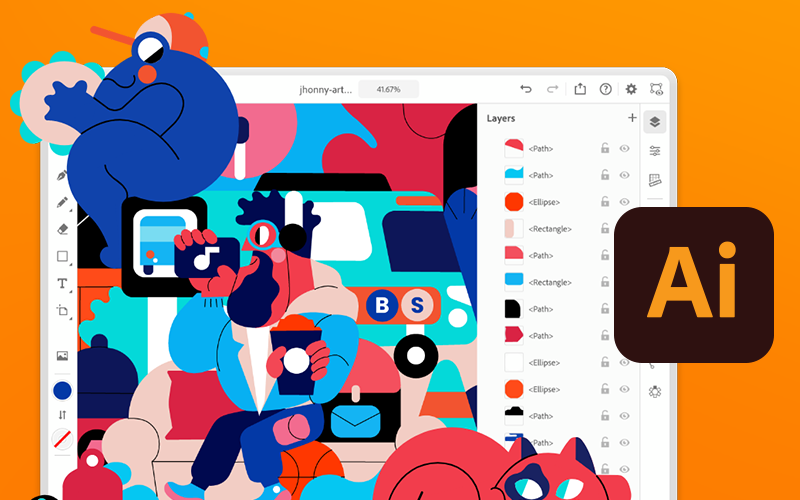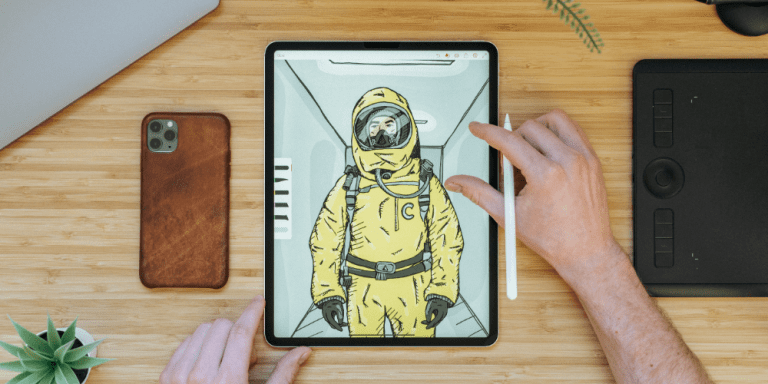Have you ever thought about becoming an illustrator, but don’t know where to start? Should you get a degree? An internship?
You might not even be sure what the job entails.
In reality, anyone can break into the industry, regardless of their experience. It just takes patience and effort.
Without getting technical, illustrators create images for clients or businesses. Usually, this means making extra parts for products, like diagrams for medical textbooks or pictures for a new line of Christmas cards.
OK, that’s great. But how do you actually get a job as an illustrator? Really, it’s the same as any career: lots of hard work. That said, it’s never been easier to get into creative industries, so let’s go over the basic steps for how to become an illustrator.

The Beginner’s Illustration Masterclass
Create professional-looking digital paintings and illustrations even if you “can’t draw.”
The Beginner’s Illustration Masterclass
Create professional-looking digital paintings and illustrations even if you “can’t draw.”
Practice, practice, practice
No surprises there. Even if you’re good with a pen (or graphics tablet), you should always be improving your skills. Most worthwhile illustrator jobs require at least a passing familiarity with the right design and illustration software.
You’ve probably heard of Adobe Photoshop, and it’s great if you can use it. But you’ll also need to use software for ‘vector graphics’. That’s a way of creating images that scale up or down without losing quality—very important for corporate work where your work might be used on a business card and a roadside billboard.
Adobe’s vector graphics tool is called Illustrator, and other popular choices include Affinity Designer and Inkscape, which is free to download and practice with.
Of course, industries also have their own preferred tools, like CAD software for engineering.

Build an illustration portfolio
Now it’s time to get serious.
Employers won’t care if you just talk about your skills: to get a job as an illustrator, you’ll have to prove them. You do that by building a portfolio with examples of your past work.
The hardest part is the beginning. How can you get work for your portfolio if you need a portfolio to get work?
To begin with, you could create designs and images just by yourself. Fire up your chosen design and illustration software, and try recreating famous designs, or remaking new logos for big companies as practice.

Another way to get experience is by volunteering for friends, family, charities or local businesses. Employers like this on a portfolio, because it means you’re self-motivated and dedicated. Just remember to mention if a piece was done for free, and always get permission before including designs in your portfolio.
Once you’ve got the beginnings of a portfolio, you’re ready for the next step.

Learn advanced illustration skills
You’re well on your way to getting a job as an illustrator, but it’s not over yet. There’s a lot of artists out there, and you want to stand out. The best way is by learning advanced or unique skills.
Often, these will be related to specific industries. For example, medical illustrators need a detailed understanding of human anatomy. More generally, it might mean mastering new techniques or mediums across different design and illustration software. Be creative—you never know what a client will want one day.
By definition, it takes more time and effort to learn advanced skills. But it’s not impossible: thanks to the internet, there are thousands of high-quality online illustration tutorials and courses for improving your skills.
The courses on this site are a great way to get started. There’ll be something to enhance your portfolio, whether it’s making logos or designing infographics.




Introduction to Adobe Illustrator
Learn Adobe Illustrator and create optimum vector graphics without any prior knowledge.
Introduction to Adobe Illustrator
Learn Adobe Illustrator and create optimum vector graphics without any prior knowledge.
Get a job as an illustrator
An important choice when learning how to get a job as an illustrator is whether to go freelance or in-house. In-house illustrators are employed by a company, like a normal job, whereas freelancers find their own clients. Both have their own pros and cons.
Freelance
Freelance illustrator jobs enable you to choose your client and what hours you work. It offers more freedom, and it’s easier to start off selling work as a freelancer.
Popular freelancers have clients come to them. They often have their own websites, and can set their rates as they like. But when you’re starting out, it’s better to join a freelancing platform to get a job as an illustrator. Some examples include Upwork, Fiverr and PeoplePerHour.


These sites handle the money for you, meaning you’ll always get paid for your work. But don’t go for big, well-paying jobs right away — you’ll need to build a good work record first. Take on small, easy jobs to get good reviews and make sure freelancing is right for you.
Once you’ve got some freelance jobs under your belt, ask your (happy) clients of they know anyone who needs similar work done. Every little bit of publicity helps.
Finally, freelance illustrator jobs are a great source of experience and material. If your work was good enough for someone to pay for it, it’s proof you’re good enough to hire again. You’re likely to sell more like it in the future, so give this work top priority in your portfolio!
In-house
If you want to work as part of a team and collaborate on big projects for even bigger companies, an in-house role might be your calling.
If you want to get a job as an illustrator in-house, and will take longer – companies tend to prefer experienced illustrators over inexperienced ones! If you’ve got a portfolio, share it in your interview and highlight your experience and connections for the best chance possible.
However, in-house work is far more reliable, and you won’t be spending lots of time finding new clients to pay the bills.
Popular sites for creative job postings include Behance, If You Could and Creativepool. But don’t forget other ways of getting your name out, like posting on social media or starting a blog to showcase your work.
Why not both?
Of course, you don’t have to choose between them. Many people take on freelance illustration jobs to gain experience, and then get a job as an illustrator in-house. You can even freelance on the side when you have a permanent job. Choose what’s best for you, and stay flexible.
Either way, make sure your portfolio is perfect, and network constantly with other artists. Connections are key!
Conclusion
Whatever path you take, trying to get a job as an illustrator is an exciting challenge!
If you work hard, improve your skills with regular work and learn as much as you can from online illustration tutorials and courses, you’ll be well-equipped to start a new career. You’ll learn how to use different design and illustration software and advanced techniques that’ll make you shine.
It doesn’t matter if you think you’re too old to switch industries or aren’t confident in your skills. What’s always important is your motivation and determination to improve.




